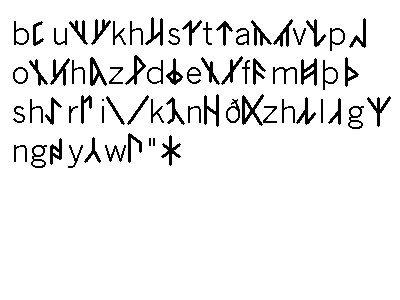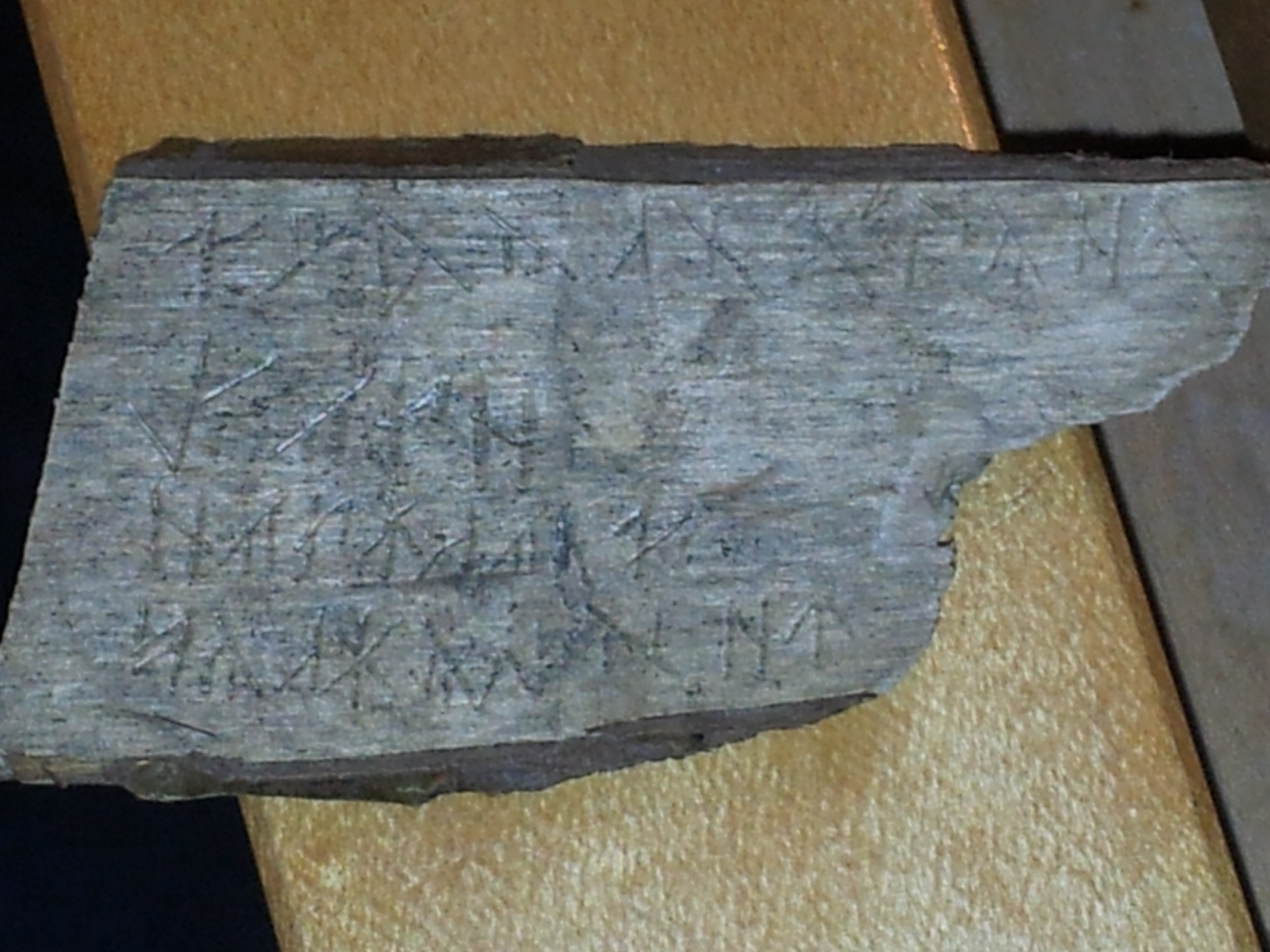The Bukhstav: Difference between revisions
No edit summary |
No edit summary |
||
| Line 2: | Line 2: | ||
[[Image:Bukhstav.gif]] | [[Image:Bukhstav.gif]] | ||
This is the native script for Khangaþyagon. It is a runic script, known as bukhstav, which means "rite sign". Notice that the first seven letters spell out the name of the script. In the illustration, each rune is preceeded by its romanisation. Each vowel has two forms. The first one shown (diagonal slanting top left to bottom right) represents the short vowel, while the second one (bottom left to top right) represents the long vowel. Diphthongs are written by writing the long form of the first element joined to the short form of the second element by the upper ends of the diagonals. The last rune shown (labelled ") is a gemination rune. It forms the phonemic geminate of the preceeding rune. It is only used intra-morphemically. If a morpheme ends with a particular phoneme and the next morpheme begins with the same one, the rune for that phoneme is written twice, and the gemination rune is not used. | This is the native script for [[Khangaþyagon]]. It is a runic script, known as bukhstav, which means "rite sign". Notice that the first seven letters spell out the name of the script. In the illustration, each rune is preceeded by its romanisation. Each vowel has two forms. The first one shown (diagonal slanting top left to bottom right) represents the short vowel, while the second one (bottom left to top right) represents the long vowel. Diphthongs are written by writing the long form of the first element joined to the short form of the second element by the upper ends of the diagonals. The last rune shown (labelled ") is a gemination rune. It forms the phonemic geminate of the preceeding rune. It is only used intra-morphemically. If a morpheme ends with a particular phoneme and the next morpheme begins with the same one, the rune for that phoneme is written twice, and the gemination rune is not used. | ||
The bukhstav is designed for carving on wood, and thus all runes are made up of straight vertical and diagonal strokes that cross the grain. Here is an example of bukhstav in its normal medium. | The bukhstav is designed for carving on wood, and thus all runes are made up of straight vertical and diagonal strokes that cross the grain. Here is an example of bukhstav in its normal medium. | ||
Latest revision as of 06:05, 18 January 2014
Bukhstav Runes
This is the native script for Khangaþyagon. It is a runic script, known as bukhstav, which means "rite sign". Notice that the first seven letters spell out the name of the script. In the illustration, each rune is preceeded by its romanisation. Each vowel has two forms. The first one shown (diagonal slanting top left to bottom right) represents the short vowel, while the second one (bottom left to top right) represents the long vowel. Diphthongs are written by writing the long form of the first element joined to the short form of the second element by the upper ends of the diagonals. The last rune shown (labelled ") is a gemination rune. It forms the phonemic geminate of the preceeding rune. It is only used intra-morphemically. If a morpheme ends with a particular phoneme and the next morpheme begins with the same one, the rune for that phoneme is written twice, and the gemination rune is not used.
The bukhstav is designed for carving on wood, and thus all runes are made up of straight vertical and diagonal strokes that cross the grain. Here is an example of bukhstav in its normal medium.
suhalekwani varni narrglæs Mallapont
| su- | hal- | ek- | wan- | i | varn- | i | narr- | glæs | mall- | ap- | ont |
| all- | time- | ADJ- | ADV- | 3p | blame- | 3p | betray- | spirit | holy- | make- | PrP |
A demon always blames the Creator.
Final note on the romanisation
If a situation occurs where two phonemes occur together whose symbols would form a digraph for a third phoneme, the romanisation uses an apostrophe to disambiguate them. This does not correspond to any feature of the bukhstav, where every phoneme has a distinct rune.
| Back | Up | Next |
|---|---|---|
| Phonotactics and Stress | Phonology | Morphology |

